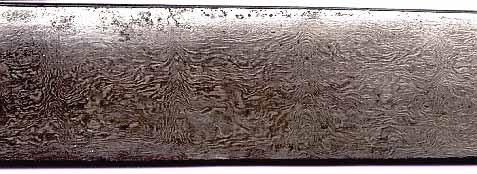
Posted on 12/07/2014 2:26:11 PM PST by smokingfrog
This "Modern Damascus" is made from several types of steel and iron slices welded together to form a billet, and currently the term "damascus" (although technically incorrect) is widely accepted to describe modern pattern welded steel blades in the trade. The patterns vary depending on how the smith works the billet. The billet is drawn out and folded until the desired number of layers are formed. In order to attain a Master Smith rating with the American Bladesmith Society, the smith must forge a damascus blade with a minimum of 300 layers.

Special thanks to the band Foreign Fields from Nashville for allowing us to use their song as a soundtrack for our documentary.
"It is a tragedy of the first magnitude that millions of people have ceased to use their hands as hands. Nature has bestowed upon us this great gift which is our hands. If the craze for machinery methods continues, it is highly likely that a time will come when we shall be so incapacitated and weak that we shall begin to curse ourselves for having forgotten the use of the living machines given to us by God."
Mahathma Ghandi
Did not read it. Is this about a birth in Kenya 53 years ago of a gay man child to a common trollop whose own parents were communists?
Yeah I thought this was going to be an Obama birth certificate thread.
“The Birth Of A Tool”
Is this about Obama?
It was discovered that the secret of the original Damascus steel was accidental, and they did not know how to reproduce it except by chance. It was Buckminsterfullerene, aka “bucky balls”.
Randomly, one of their swords would have a greater than average amount of it in their steel, making that blade exceptional: stronger, less brittle, with a sharper edge.
Because these blades were so special, all Damascus steel was highly prized. For the most part they were ordinary, however.
True Damascus is not made by pattern welding but by the
process of smelting iron with carbonaceous materials in
a neutral environment, a sealed crucible.
Pattern welded steel is not that hard to make or manipulate.
I’ve been doing it for decades.
Wootz is probably the closest to Damascus of the turn of
the century methods.
Three hundred layers takes a little time and I have made
some with a thousand layers, but the pattern becomes
very fine and hard to distinguish so most don’t develop
it that far.
I used to scour the second hand and junk shops looking for old turkey carving sets that were Damascus steel. Found a few that I reshaped and re-handled into lovely hunting knives. Beautiful stuff!
For your interest.
When I was a kid in the 50s I used to see Mora Knives from Sweden advertised in the outdoor magazines. They were made of three layers, the middle of hard steel laminated between two layers of softer iron.
They looked very simple and inexpensive with an ordinary looking wooden handle but they had a great reputation.
Large size.
Lapland curly birch handle
Weight: 0.50 lbs (230 gr)
Overall length: 10” (252 mm)
Blade length: 5” (127 mm)
Handle length: 4.72” (120 mm)
Blade width: 1.02” (26 mm)
Blade thickness: 0.11” (3.0 mm)
Hardnes: Rockwell 61 (HRC)
When I saw the title of this thread, I thought it was Obama’s birthday. Then I remembered his birthday is in August.
They are excellent knives. I bought some in Norway. The middle layer is very hard steel and holds an edge well. However it it is brittle. The mild steel on the outer layers gives the knife its strength so it does not break.
Apparently, high quality knife steel is not that expensive. Around 60 years ago, I bought and Imperial sheath knife brand new for $1.00.
It had imitation bone plastic handles and the guard was a stamping but the blade itself was and is excellent. It is easy to sharpen and holds an edge. That is one reason that it irritates me to find a knife with poor quality steel.
I once bought a “Western” brand bowie which was really large and heavy and not cheap either. The steel was so poor that the edge actually bent when I was chopping at some hard wood.
Other Western brand knives were OK.
I read about Damascus steel in Science Digest probably 35 years ago. As I remember it they said it was super high carbon content but the kneading gave it properties way different than most high carbon steels. It sounds like it was pretty amazing stuff. Wikipedia has a pretty good take on it
Damascus steel
http://en.wikipedia.org/wiki/Damascus_steel
Nah, if it said “dull tool” then, yeah, about Øbama
Yes, that looks like the one made in the video.
$610 will buy you one.
Disclaimer: Opinions posted on Free Republic are those of the individual posters and do not necessarily represent the opinion of Free Republic or its management. All materials posted herein are protected by copyright law and the exemption for fair use of copyrighted works.